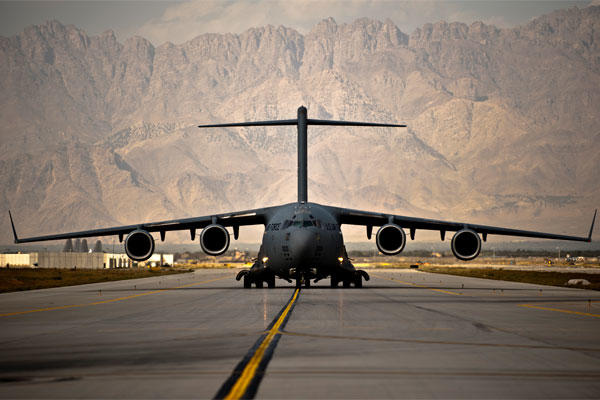The U.S. Air Force has saved hundreds of millions of dollars by changing the way it flies equipment out of Afghanistan, using shorter trips to the Persian Gulf rather than direct routes to the United States, a general said.
A fleet of a dozen C-17 cargo planes and additional commercial aircraft lift the gear from Kandahar and other bases in Afghanistan to ports in the Gulf, where it's loaded onto ships bound for the U.S., according to Gen. Paul Selva, commander of Air Mobility Command, based at Scott Air Force Base in Illinois.
"The savings are astronomical," he said last week during a Sept. 17 briefing with reporters at the Air Force Association's Air & Space Conference and Symposium at National Harbor, Md. "We've documented now this past year $400 million of essentially cost avoidance."
The Defense Department plans to spend between $5 billion and $7 billion removing equipment from Afghanistan as part of a plan to withdrawal combat forces from the country by the end of 2014. The cheapest route is to truck the materiel through Pakistan to the port of Karachi, then load it onto ships for transportation across the ocean. But the Pentagon has relied more heavily on air transportation after a customs dispute with the Afghan government over container fees.
The reworked air routes mean shorter trips and more lifts per day, according to Selva.
"You're only flying four hours from Kandahar or one of the other locations in Afghanistan to the Persian Gulf," he said. "You can get two or three lifts in a day, as opposed to running back and forth all the way across the Atlantic Ocean, where you get one or two lifts a week. That has really increased the efficiency."
The Air Force has also boosted the amount of equipment being carried aboard the Boeing Co.-made aircraft on re-supply missions into the country, according to Selva.
"Those same airplanes … don't go in empty to pick up cargo and bring it out," he said. "They fly into Afghanistan to do a resupply mission and they come out of Afghanistan with retrograde cargo. In a normal load of combat efficiency, you'd be looking at 50 percent of those missions actually being reasonably full in both directions. Last month, we hit 90 percent."
The Pentagon plans to remove some 24,000 vehicles and 20,000 shipping containers from Afghanistan by the end of next year. It's currently transporting most of the gear by air, with about half going to intermediate ports in the Gulf. The goal is to eventually truck a majority of the equipment through Pakistan before shipping it stateside.
The Afghan government this summer temporarily closed its border with Pakistan to coalition shipments after the U.S. refused to pay $1,000 in customs fees for every container leaving the country without proper documentation. While the issue was reportedly resolved, both countries continue to discuss the logistics of the planned U.S. withdrawal.
The U.S. and its NATO allies have faced similar problems in the past.
In 2011 Pakistan closed resupply routes to coalition forces after helicopter strikes killed two dozen Pakistani soldiers at border posts. The closures forced the U.S. military to move equipment on a sprawling, costlier network of roads and railways through countries to the north, including Russia.
The price of transporting supplies through the so-called northern distribution network last year was estimated at $15,800 per container, compared to $6,200 per container through Pakistan.
The U.S. military has about 60,000 troops in Afghanistan. That number is set to drop to about 34,000 by February, President Barack Obama has said. No decision has been made as to how many American troops will remain in the country after next year to help train Afghan security forces.





























